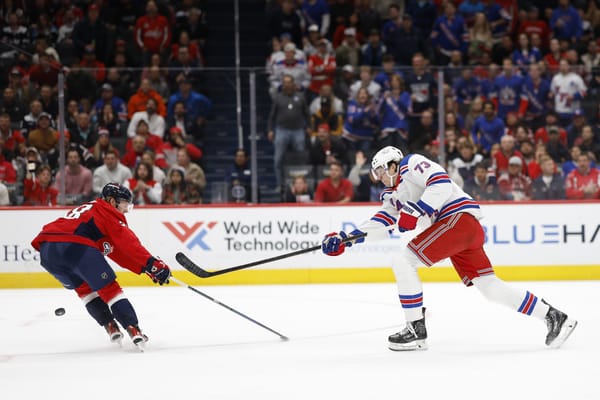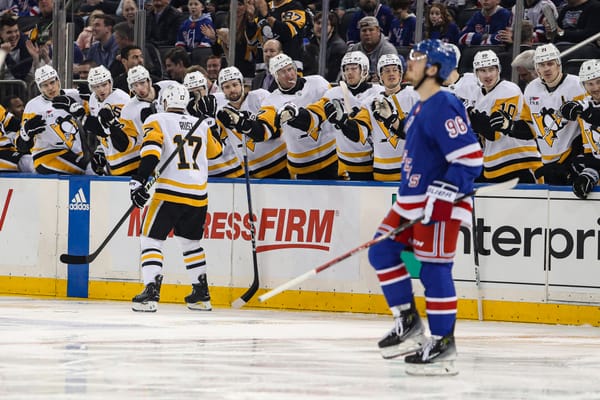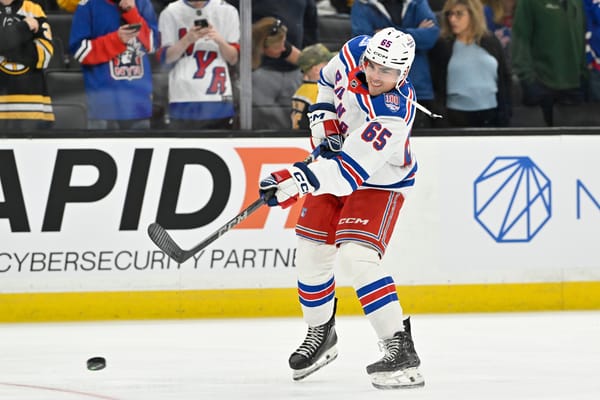The Rangers’ Three Goalie Situation Won’t Be Tolerable for Long
Promoting Igor Shesterkin to the NHL and rotating three goaltenders is a temporary solution that will soon enough create new problems.
One could never accuse the Rangers of being ill-prepared for the inevitability of Henrik Lundqvist’s descent from the throne. From 2013 through 2018, the Blueshirts added a total of 12 young goaltenders of various ages and pedigrees. They trusted that natural selection would do its job and that whenever The King’s clock was winding down, they’d have the talent in place to carry on with competitive NHL goaltending.
While there may have been individual missteps along the way in terms of certain acquisitions and some developmental errors, it’s hard to argue with the overall outcome. While multiple NHL teams search desperately for one goaltender who won’t sabotage their results, the Rangers find themselves with three goaltenders who have earned a heavy NHL workload.
As we’ve referenced in 2018 and again at the start of this season, good problems are still problems. The Rangers have staved off a logjam as long as they could, and to be frank, Igor Shesterkin did the team a massive favor by patiently waiting in the AHL way longer this his performances justified. Was it Shesterkin and his agent who forced the Rangers’ hand here, voicing a desire to return to Russia if a call-up was not imminent? Or was General Manager Jeff Gorton proactive in promoting Shesterkin, hoping to avoid such a confrontation while eager to get a look at his prized prospect in the face of a future goaltending decison to be made?
Whatever the case, the Rangers have played their last card, which is to resort to this awkward Cerberus. Keeping all three goaltenders in the NHL is a solution on paper.
It is not a solution in application. At least, it won’t be for long. Henrik Lundqvist and Alexandar Georgiev have and will continue to say the right things publicly, but privately it’s hard to imagine they are thrilled with the situation. The two have combined to bail out the Rangers on a number of occasions this season and were already fighting for their shares of playing time. Their reward now is even less time in net.
The Rangers are not the first team to endure a three-goalie rotation. Many goaltenders have experienced it. If not at the NHL level, then in minors or junior. You’ll be hard-pressed to find any who would describe that scenario with anything but horror. Egos play a role, but the bigger concern is their own developmental and training needs. Goaltenders are highly dependent on routine and repetition. It’s going to be hard to develop a routine with three goaltenders in the mix, as one or two could easily go many days without consistent playing time. And with such infrequent playing time, it will be hard to build on their play. Practice helps, but it cannot mimic the spontaneity of live action, nor can it replicate the focus necessary to concentrate and execute in high-pressure situations.
Yet practice, too, will become less fulfilling. Goaltenders and goalie coaches are generally dissatisfied with their allotments of true practice time as is. Goalies are often forgotten during team practice. The coaches spend most of the time working on systems and situations like neutral zone setups, power play passing, faceoff plays, and other issues in which goaltenders spend most of the time standing around and serving as glorified shooter tutors. With the little icetime they have to focus on themselves, typically after actual team practice, they’re working on their mechanics, depth in the crease, shot recognition, timing, and so on. Three goaltenders will obviously spread Goaltender coach Benoit Allaire’s efforts.
Finally, there’s the mental component. The players aren’t ignorant. They know that holding three goaltenders on the roster is not a long-term fix, nor would they want it to be. The longer this endures, the more aware they’re going to become of the Sword of Damocles. Competition can be good to a degree. At some point, people in all walks of life appreciate a sense of job security, which none of the three currently have.
Alexandar Georgiev is up for a new contract in the summer. Multiple teams are assuredly reaching out to Gorton regarding a trade. Some are anticipating a playoff push and some would be offering him an increased role. It’s a business, and the Rangers have to look out for their own interests, but that’s not a scenario conducive to keeping Georgiev in good spirits and getting the most out of him.
To play Henrik Lundqvist frequently would cut into limited time the Rangers have to develop and evaluate the two young Russian goaltenders. If we’re being truly honest about the team’s long-term needs, Lundqvist is not a priority. But Lundqvist is still playing at an all-star level. How could the players possibly take Head Coach David Quinn seriously about prioritizing a winning culture and trying to make the playoffs when the team’s best goaltender is seeing a decrease in icetime?
It’s not that the Rangers have made the wrong decision here, but rather that this (probably astute) decision will only buy them so much runway. The team has 41 games remaining with which to evaluate two young goaltenders before they have to decide which one they entrust as the backbone for the next decade and which one they will move on from, while also giving Lundqvist enough playing time to keep him and the locker room content and ambitious. Even if they manage to avoid any drama, it still leaves them a very small window with which to make a franchise-altering decision.
Management has a number of issues to resolve in the coming months. None are as delicate and consequential as the current goaltending conundrum. The Rangers are at the final stages of a process that has been in the making for nearly seven years. One misstep now could render the entire journey a failure.




